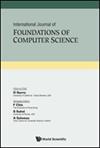基于哈密顿量的具有邻居扩散效应的合法化有效算法
IF 0.6
4区 计算机科学
Q4 COMPUTER SCIENCE, THEORY & METHODS
International Journal of Foundations of Computer Science
Pub Date : 2023-02-16
DOI:10.1142/s0129054122460108
引用次数: 0
摘要
邻居扩散效应(NDE)是先进技术节点中的一个关键方面,它以电路性能显著下降的臭名昭著的后果而闻名。在本文中,我们观察到NDE是由两个相邻单元之间不同的扩散高度(翅片数量)引起的,并考虑减少单行中的高度差数量,以减少NDE违规行为。忽略单元的移动,我们首先提出了一种基于哈密顿完成的算法,该算法对行中的单元进行重新排序,从而将NDE违规次数减少到接近最优的值。然后,对于给定的固定整数[公式:见正文],我们设计了一种算法来计算单元的新位置,使得无损检测违规的数量受[公式:参见正文]的限制,并且最大位移最小化。此外,我们扩展了针对混合高度单元格的多行合法化算法。实验结果表明,与符合理论分析的基线相比,我们的算法在没有任何面积开销的情况下将NDE违规减少到接近最优的最小值,同时实现了更好的实际运行时间。本文章由计算机程序翻译,如有差异,请以英文原文为准。
Hamiltonian-Based Efficient Algorithms for Legalization with Neighbor Diffusion Effect
Neighbor diffusion effect (NDE) is a crucial aspect in advanced technology node that is well-known for its infamous consequence of significant performance decrement of the circuit. In this paper, we observe that NDE is caused by different diffusion heights (the number of fins) between two adjacent cells, and consider reducing the number of height differences in single row to reduce NDE violations. Ignoring the movement of the cells, we first propose a Hamiltonian-completion-based algorithm that reorders the cells in the row such that the number of NDE violations is reduced to a near-optimal value. Then, for a given fixed integer [Formula: see text], we devise an algorithm to compute the new positions of cells, such that the number of NDE violations is bounded by [Formula: see text] and the maximum displacement is minimized. Moreover, we extend our algorithm for legalization in multiple rows against mixed-height cells. Experimental results show that our algorithm reduces the NDE violations to a near-optimal minimum without any area overheads while achieving a better practical running time compared to baselines conforming with the theoretical analysis.
求助全文
通过发布文献求助,成功后即可免费获取论文全文。
去求助
来源期刊

International Journal of Foundations of Computer Science
工程技术-计算机:理论方法
CiteScore
1.60
自引率
12.50%
发文量
63
审稿时长
3 months
期刊介绍:
The International Journal of Foundations of Computer Science is a bimonthly journal that publishes articles which contribute new theoretical results in all areas of the foundations of computer science. The theoretical and mathematical aspects covered include:
- Algebraic theory of computing and formal systems
- Algorithm and system implementation issues
- Approximation, probabilistic, and randomized algorithms
- Automata and formal languages
- Automated deduction
- Combinatorics and graph theory
- Complexity theory
- Computational biology and bioinformatics
- Cryptography
- Database theory
- Data structures
- Design and analysis of algorithms
- DNA computing
- Foundations of computer security
- Foundations of high-performance computing
 求助内容:
求助内容: 应助结果提醒方式:
应助结果提醒方式:


